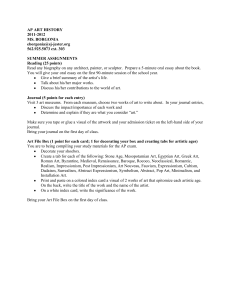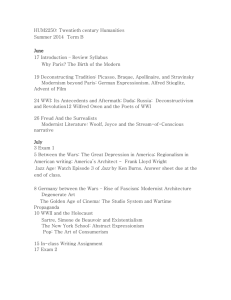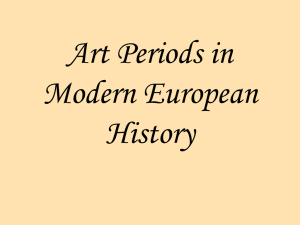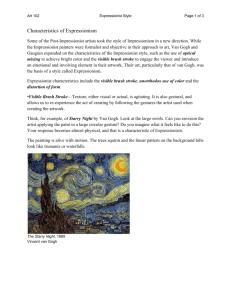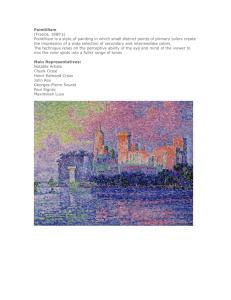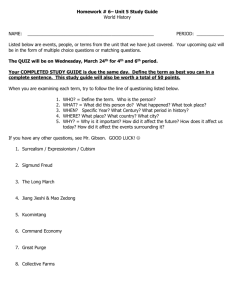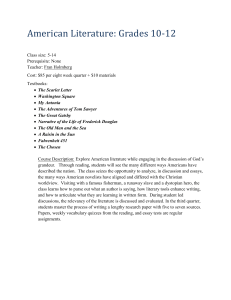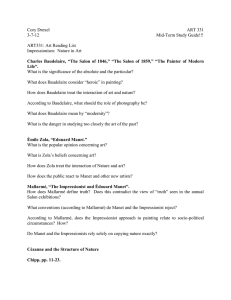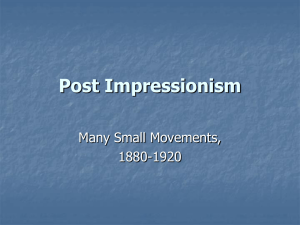AP EURO SEMINAR NIGGA
advertisement
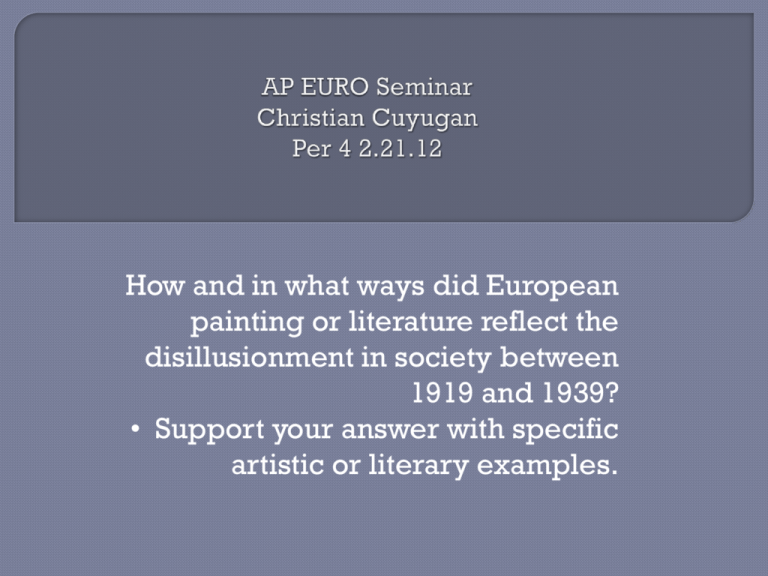
How and in what ways did European painting or literature reflect the disillusionment in society between 1919 and 1939? • Support your answer with specific artistic or literary examples. Disillusionment: to free or be freed from illusion. The general environment of pessimism, relativism, and alienation was articulated in literature. Novelists developed new techniques to express new realities. Focused attention on the complexity and irrationality of the human mind, where feelings, memories, and desires are mixed up. Serious Novelists used stream-of-consciousness technique to explore psyche. Jacob’s Room (1922), Virginia Woolf (1882-1941) created a novel made up of a series of monologues, in which ideas and emotions bubble up randomly from different periods of time. As creative writers turned their attention from society to the individual and from realism to psychological relativity, the idea of progress was rejected. The Decline of the West (1918), Oswald Spengler explains every culture experiences a life cycle of growth and decline. Western civilization in his opinion was in its old age, and death was approaching by conquest. The Waste Land (1922), T.S. Eliot (1888-1965) depicts a world of growing despair. The Trial (1925), The Castle (1925), Franz Kafka (1883-1924) portrayed helpless individuals crushed by hostile forces. Modern painting grew out of a revolt against French impressionism. (conveying experience by impressions of reality) French painters such as Pierre August Renoir, Claude Monet, and Camille Pissaro sought to capture the momentary overall feeling or impression, of light falling on a real-life scene before their eyes. Artists known as postimpressionists were united to desire and depict worlds other than what is reality. Like modern novelists, they wanted to express a complicated psychological view of reality as well as an overwhelming emotional intensity. Paul Gauguin (1848-1903) believed form and design of a picture were important in themselves and the painter should try not to represent them as the eye saw them. Fascination with form, was characteristic of postimpressionism and expressionism(forms derived from nature are being distorted). Dutch expressionist Vincent van Gogh (1853-1890) : The Starry Night (1889). Van Gogh went beyond the portrayal of external reality, painting an inner world of intense emotion and wild imagination he greatly contributed to the rise of expressionism. Paul Cezanne (1839-1906) committed to form and ordered design. Still Life with a Curtain (1895) illustrates Cézanne's increasing trend towards terse compression of forms and dynamic tension between geometric figures. The expressionism of Henri Matisse (1869-1954) was so extreme that his group of painters shocked critics and wanted to be called “the wild beasts” In Spain, Pablo Picasso (1881-1973) founded cubism, which concentrated on a complex geometry of zigzagging lines and overlapping planes. Three Musicians (1921) - The three jagged figures from traditional Italian comedy seem to convey the atmosphere of theater and the rhythm of modern music. Guernica (1937)- Inspired by the Spanish civil war and the deadly terror bombing of Guernica. In the 1920s and 1930s , artistic movements of the prewar years were extended and consolidated. Dadaism attacked all accepted standards of art and behavior, delighting in outrageous conduct. Example of Dadaism: Leonardo da Vinci’s Mona Lisa where the mysterious and famous woman has a mustache and is ridiculed. After 1924 many Dadaists were attracted to surrealism. Surrealism painted a world of wild dreams and complex symbols. Surrealist painters made powerful statements about the age of anxiety. Literature focused on the complexity and irrationality of the human mind. Novelists such as Woolf, Faulkner, and Joyce adopted the stream-ofconsciousness technique, in which ideas and emotions from different time periods bubble up randomly. Some literature, such as that of Spengler, Kafka, and Orwell, was anti-utopian--it predicted a future of doom. French impressionism yielded to nonrepresentational expressionism, which sought to portray the worlds of emotion and imagination, as in the works of van Gogh, Gauguin, Cézanne, and Matisse. Nonrepresentational art turned away from nature completely; it focused on mood, not objects. Dadaism delighted in outrageous conduct. Surrealists, inspired by Freud, painted wild dreams and complex symbols.
